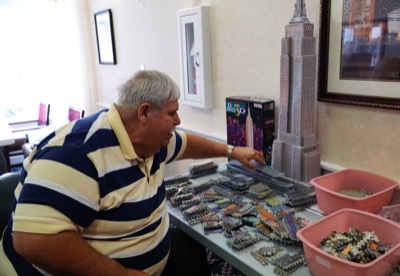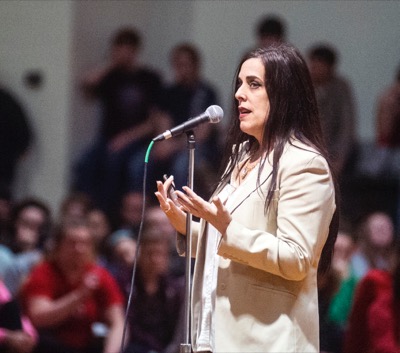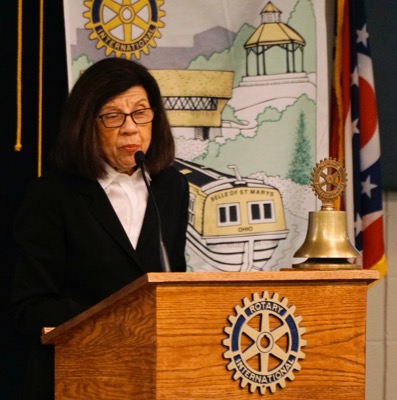Thursday, April 6th, 2017
Local man beats long odds for hemophilia
By Sydney Albert

Photo by Mark Pummell/The Daily Standard
Ron Klosterman organizes pieces of his 3-D puzzle depicting the New York City skyline. A completed Empire State Building puzzle sits in the background.
CELINA - The life expectancy for children with hemophilia was about five years when Ron Klosterman was born in 1948.
Now at 68, Klosterman is one of the oldest living hemophiliacs in the country.
"My goal in life is to reach 100 years of age," he said. "I want to be the oldest living hemophiliac. Right now I'm one of the older ones living but not the oldest."
Still, making it to the age of 68 is a feat. Most people of his generation with hemophilia didn't make it past middle age, he said.
Klosterman recounted the story of Ryan White, a boy with hemophilia who became infected with the HIV virus after having received an infected blood transfusion in the 1980s. He later died due to complications of AIDS. Many others with hemophilia at that time also became infected with diseases such as AIDS and hepatitis, he said.
"It wiped half of us out because they didn't pasteurize (the blood) and treat it, and that's how a lot of us got the AIDS virus," he said.
Klosterman had three cousins with hemophilia who all died of AIDS after receiving infected blood.
"Just dumb luck it missed me," he said.
Still, he wasn't left completely unscathed. In second grade Klosterman spent 32 weeks at Cincinnati Children's Hospital Medical Center having received transfusions, and he ended up with hepatitis C. Despite it all, he said he had a good childhood.
Klosterman grew up on a family farm east of Montezuma on state Route 219 and graduated from Celina High School.
"I probably drove my dad and mom crazy because there was nothing that I wouldn't do," he recalled. "I played basketball, baseball, football - any contact sports I shouldn't have been doing, but that wasn't going to stop me. I did everything any normal boy would do all through my high school, college career."
When he graduated from high school, he wanted to be a heavy equipment operator or drive a semi, but his father insisted he get a college education because of his condition. He earned an accounting degree and worked for Mercer Landmark in Chickasaw for about 20 years before finally leaving to become a truck driver.
Then the patella tendon in his knee became infected, and his right leg was amputated.
"I know when I lost my leg, I thought that was the worst time of my life until I went down to rehab," he said. "They wheeled me in, and there was two [others] laying there. They was paralyzed from the neck down. All of a sudden, you ain't got it bad because at least back then I could stand up and walk with two crutches."
With less than 1 percent of clotting agent in his body, he has one of the severest forms of hemophilia, and sometimes medicines that work for others with the disease won't work for him. After he started bleeding in his abdomen and no single drug could stop it, doctors mixed two drugs in a last-ditch effort to save him. Klosterman then suffered a stroke that initially paralyzed his left side.
Klosterman re-mains optimistic about life despite everything he's been through.
"You gotta be. You can't get down on anything ... It ain't doom and gloom. I wouldn't change a thing in my life, except for being here," he said, referring to the Celina Gardens.
He moved into the facility last year, and though he says he likes the people and the activities, he still misses living on his family farm in Montezuma.
"Other than that, I have no problem with my life at all, and I don't know if many people can say that."
He can move his left arm now, which comes in handy for his hobbies. Klosterman loves puzzles and is working on a 3-D puzzle of the New York City skyline. The 3,000 pieces will come together to stand about 22-23 inches tall, he said.
Klosterman said he believes resources for hemophiliacs have gotten better over the years, noting that those in Ohio have access to medical centers in big cities and universities that work with hemophiliacs.
"We're lucky, because I know out west, some are 300-400 miles from the nearest hemophilia center. That's a big problem out there," he said.
Local doctors and even dentists don't always want to work with him, however, and hemophilia remains an expensive disease, he said. His medication alone could cost about $25,000, if not more. Even now he doesn't own much.
"You can never build wealth up, but I mean ... your health is your wealth. If you're healthy and feeling good, you're wealthy."


